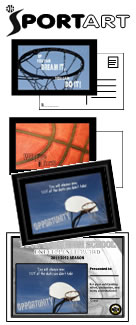assist:
the last pass to a teammate that leads directly to a field goal; the scorer must move immediately toward the basket for the passer to be credited with an assist; only 1 assist can be credited per field goal.
backcourt:
the area from the midcourt line to the end line furthest from the offense's basket.
bank shot:
a shot where the ball is first bounced (or banked) off the backboard at such an angle that it then drops into the basket.
baseline (end line):
the boundary line behind each basket. The line is out of bounds.
basket:
attached to the backboard, it consists of a metal rim 18" in diameter suspended 10' from the floor, from which a 15-18" corded net hangs, and through which points are scored; also used to refer to a successful field goal.
blind pass:
a pass from a ball handler who does not see his receiver, but is estimating where he should be.
blocked shot:
the successful deflection of a shot by touching part of the ball on its way to the basket, thereby preventing a field goal.
blocking:
the use of a defender's body position to legally prevent an opponent's advance; the opposite of charging.
boxing out:
a player's attempt to position his body between his opponents and the basket to get rebounds and prevent the opponents from doing so.
center circle:
the circular area at midcourt from which jump balls are taken.
charging:
an offensive foul which occurs when an offensive player runs into a defender who has established position.
clear out:
teammates move away from teammate with ball and allow him to dribble to basket.
crossover dribble:
when a ball handler dribbles the ball across his body from one hand to the other.
dead ball:
any ball that is not live; occurs after each successful field goal or free-throw attempt, after any official's whistle or if the ball leaves the court; it stops play which is then resumed by a jump ball, throw-in or free-throw.
defense:
the act of preventing the offense from scoring; the team without the ball.
defensive rebound:
a rebound by a player on defense.
double team (trapping):
when two teammates join efforts in guarding a single opponent.
elbowing:
it is a violation if a player vigorously or excessively swings his elbows, even if there is no contact; it is a foul if contact is made, and an automatic ejection if that contact is above shoulder level.
established position:
when a defensive player has both feet firmly planted on the floor before an offensive player's head and shoulder get past him; the offensive player who runs into such a defender is charging.
fake:
a deceptive move to throw a defender off balance and allow an offensive player to shoot or receive a pass; players use their eyes, head or any other part of the body to trick an opponent.
fast break:
also called the run-and-shoot offense, it begins with a defensive rebound by a player who immediately sends an outlet pass toward midcourt to his waiting teammates; these teammates can sprint to their basket and quickly shoot before enough opponents catch up to stop them.
field goal:
when the ball enters the basket from above during play; worth 2 points, or 3 points if the shooter was standing behind the 3-point line.
flagrant foul:
unnecessary or excessive contact against an opponent.
floor violation:
a player's action that violates the rules but does not prevent an opponent's movement or cause him harm; penalized by a change in possession.
forwards:
the 2 players on the court for a team who are usually smaller than the center and bigger than the guards.
foul:
actions by players which break the rules but are not floor violations; penalized by a change in possession or free-throw opportunities; see personal foul or technical foul.
foul lane:
the painted area 19' x 12' bordered by the end line and the foul line, outside which players must stand during a free-throw; also the area an offensive player cannot spend more than 3-seconds at a time in.
4-point play:
a 3-point shot followed by a successful free-throw.
free-throw (foul shot):
an unguarded shot taken from the foul line by a player whose opponent committed a personal or technical foul; it is worth 1 point.
free-throw line (foul line):
the line 15' from the backboard and parallel to the end line from which players shoot free-throws.
free-throw line extended:
an imaginary line drawn from the free-throw line to the sideline to determine the location for certain throw-ins.
frontcourt:
the area between the midcourt line and the end line closest to the offense's basket.
full-court press:
when defenders start guarding the offense in the backcourt.
guards:
the 2 or 3 players on each team who are the smallest on the court; they usually handle setting up plays and passing to teammates closer to the basket.
guarding:
the act of following an opponent around the court to prevent him from getting close to the basket, taking an open shot or making easy an pass, while avoiding illegal contact.
half-court or set offense:
when a team takes the time to develop a play in its frontcourt, such as the give-and-go or a screening play; opposite of fast break.
high percentage shot:
a shot that is likely to go in the basket, such as a layup.
high post:
an imaginary area outside either side of the foul lane at the free-throw line extended.
in the paint:
being in the foul lane area which is painted a different color.
inbounds:
the area within the end lines and sidelines of the court; also the act of bringing the ball into this area by means of a throw-in.
incidental contact:
minor contact usually overlooked by officials.
jump ball:
2 opposing players jump for a ball an official tosses above and between them, to tap it to their teammates and gain possession; used to start the game (tip-off) and all overtime periods, and sometimes to restart play.
keepaway game:
a tactic used by the team that is leading near the end of a period to keep the ball from its opponents to prevent them from scoring while using up time off the game clock; also called freezing.
key or keyhole:
the area at each end of the court consisting of the foul circle, foul lane and free-throw line; named for the shape it had years ago.
layup or layin:
a shot taken after driving to the basket by leaping up under the basket and using one hand to drop the ball directly into the basket (layin) or to bank the ball off the backboard into it (layup).
loose ball:
a ball that is alive but not in the possession of either team.
low post:
an imaginary area outside either side of the foul lane close to the basket.
lower percentage shot:
a shot that is less likely to go in the basket, such as one thrown by a player who is off balance or outside his shooting range.
man-to-man defense:
the defensive style where each defensive player is responsible for guarding one opponent.
match-ups:
any pairing of players on opposing teams who guard each other.
offense:
the team with possession of the ball.
offensive rebound:
a rebound by a player on offense.
officials:
the crew chief, referee and umpire who control the game, stop and start play, and impose penalties for violations and fouls.
1-and-1 or 1-plus-1:
a free-throw attempt awarded for certain violations that earns the shooter a 2nd attempt only if the first is successful.
out of bounds:
the area outside of and including the end lines and sidelines.
over the limit:
when a team commits more than 6 team fouls per period.
overtime or OT:
the extra period(s) played after a regulation game ends tied.
period:
any quarter, half or overtime segment.
perimeter:
the area beyond the foul circle away from the basket, including 3-point line, from which players take long-range shots.
personal foul:
contact between players that may result in injury or provide one team with an unfair advantage; players may not push, hold, trip, hack, elbow, restrain or charge into an opponent; these are also counted as team fouls.
pick and roll:
when an offensive teammate sets a screen on teammate with ball and rolls to basket once player with ball uses the screen.
pivot:
a center; also the foot that must remain touching the floor until a ball handler who has stopped dribbling is ready to pass or shoot.
possession:
to be holding or in control of the ball.
possession arrow:
used to determine which team's turn it is to inbounds the ball to begin a period or in a jump ball situation.
post position:
the position of a player standing in the low post or high post.
rebound:
when a player grabs a ball that is coming off the rim or backboard after a shot attempt; see offensive rebound and defensive rebound.
screen or screener (pick):
the offensive player who stands between a teammate and a defender to gives his teammate the chance to take an open shot.
sidelines:
2 boundary lines that run the length of the court. The line is out of bounds.
squaring up:
when a player's shoulders are facing the basket as he releases the ball for a shot; considered good shooting position.
strongside:
the side of the court the ball is on.
team fouls:
each personal foul committed by a player is also counted against his team; when a team goes over the limit, its opponent is awarded free-throw opportunities.
technical fouls or Ts:
procedural violations and misconduct that officials believe are detrimental to the game; penalized by a single free-throw opportunity to the non-offending team (2 free-throws in college).
timeout:
when play is temporarily suspended by an official or at the request of a team to discuss strategy or respond to an injured player; there are full timeouts 30-second timeouts.
tip-off:
the initial jump ball that starts the game.
transition:
the shift from offense to defense.
traveling:
a floor violation when the ball handler takes too many steps without dribbling; also called walking.
turnover:
when the offense loses possession through its own fault by passing the ball out of bounds or committing a floor violation.
V-cut:
when an ofensive player without the ball fakes to go one directoin and then goes another.
weakside:
the side of the court away from the ball.
wing position:
the guard 2 or 3 position in an offensive set. The sides where guards position themselves.
zone defense:
a defense where each defender is responsible for an area of the court and must guard any player who enters that area.
3-point play:
a 2-point field goal followed by a successful free-throw.
3-point shot:
a field goal worth 3 points because the shooter had both feet on the floor behind the 3-point line when he released the ball; also counts if one foot is behind the line while the other is in the air.
|




